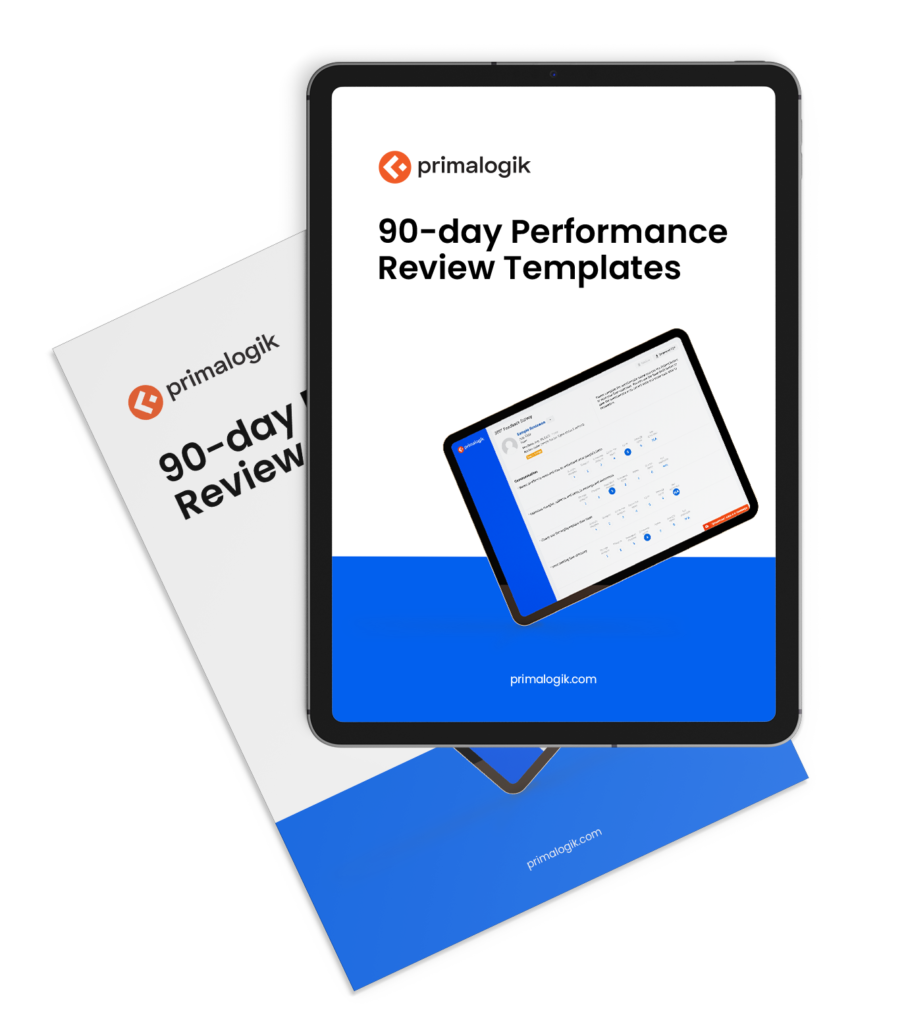Many companies today are adopting longer onboarding processes that span three months. By doing so, they provide the ongoing support that new hires need. 90-day performance reviews take place after an employee’s first three months on the job. This formal meeting marks the end of the onboarding process. Moreover, it helps employees gain clarity on how they’ve been performing.
Performance Review Software can assist you in delivering 90-day reviews. You probably have many points to cover, and the right tools can keep you organized.
We know these reviews can feel daunting. That’s why we’re going to guide you through every aspect of the 90-day review process. We’ll begin by exploring what it involves before delving into key benefits and challenges. We’ll then share essential guidance on planning and conducting the 90-day review.
Navigation
1. What 90-Day Performance Reviews Entail
2. Why Hold 90-Day Performance Reviews?
3. Challenges in Conducting 90-Day Reviews
1. What 90-Day Performance Reviews Entail
Let’s take a more in-depth look at the reason for holding 90-day performance reviews. Then, we’ll consider who you should conduct these reviews for and their typical format.
The Purpose of 90-Day Reviews
- Helping managers confirm that a new employee is the right fit. (If the company has hired wisely, this will probably be the case.)
- Providing the new hire with valuable guidance. By this time, the manager has a solid understanding of how the employee performs. The review allows for in-depth reflection on whether the employee is on the right track.
- Helping to course-correct early on, if need be. If issues are identified, the manager and employee can work to resolve them.
Managers should frame the 90-day review in this way to avoid causing stress. Simply put, it serves as a chance to learn and grow.
Who Should Receive 90-Day Reviews
Conduct 90-day reviews with all of these employees:
- New hires who recently joined the company.
- Those who have transitioned laterally to a new role.
- Those who were recently promoted.
Some of these employees are brand-new to your company and its culture. Others may have been with your company for years. However, they are navigating a brand-new role that brings a new set of challenges. They may be joining a new department or managing a team for the first time. They need support just as much as new hires. This means they will also benefit from a thorough 90-day review.
Format: Best Practices
The 90-day review can have a very similar format to any other performance review. These days, you may be delivering reviews virtually. Fortunately, you can hold effective reviews by video chat or in person. We’ll share tips that apply to both situations.
2. Why Hold 90-Day Performance Reviews?

The 90-day review can bring all of the following benefits:
- Establishing expectations. You may need to clarify existing expectations. You may also need to set new ones for the future.
- Helping employees understand how they’re performing. They’ll gain a clear overview of their progress over the past several months.
- Strengthening areas of weakness. The review provides a chance to create a plan for improvement.
- Gaining valuable input about the onboarding experience. Managers gain feedback about what is working and what could improve.
- Boosting job satisfaction. Holding thoughtful performance reviews boosts employee engagement. They feel valued when their manager actively nurtures their growth.
- Establishing an ongoing feedback loop. Set expectations for how often you’ll check in about progress. For instance, plan to hold formal meetings once per quarter.
- Enhancing the employee/manager relationship. The 90-day review strengthens the foundation of this relationship by providing critical support.
The employee experience in the first three months can be a game-changer—for better or worse. Consider that 33% percent of employees quit within the first 90 days. However, holding 90-day performance reviews can help you earn their loyalty. By promoting engagement and nurturing growth, you’ll help employees envision a future with your company.
3. Challenges in Conducting 90-Day Reviews

Let’s take a look at two common challenges and how to address them.
- Problem: They can cause more anxiety for employees than the typical review. Employees may fear they could be let go if they haven’t met expectations. They may not yet have an established track record of success within their position. They may, therefore, be more likely to fear they are falling short.
Solution: Avoid calling it a “probationary review” or referring to the first 90 days as a “probationary period.” This language suggests employees might be let go if they don’t measure up. (Plus, it may be legally inaccurate!) Emphasize that the review will promote their professional growth. - Problem: Holding a performance review over video chat may feel awkward. Communication may not flow as smoothly. And as we all know, body language is harder to read through a screen.
Solution: Carefully communicate the format of the review. Share the agenda by email a day or so in advance. When you start the review, set guidelines for who will speak when. You might say, “I’ll begin by pointing out some of your accomplishments for your first 90 days. Then, I would like to hear your perspective on what you’ve accomplished.” Do the same as you introduce each agenda item. That way, you won’t be interrupting each other or waiting for one another to speak.
Also, take a moment to lighten the mood at the beginning of the review. Smile and engage in a bit of chit-chat. An upbeat attitude promotes a candid conversation.
4. Planning 90-Day Reviews
Thoughtful planning will help you get the most from 90-day reviews. Take the following steps to set yourself up for success.
1. Begin by setting an agenda
Your agenda will structure the discussion. Include items such as these:
- Assess progress toward goals set for the first 90 days. Determine whether the employee has achieved them. If not, pinpoint what will bring them closer to these goals.
- Set new goals for the future. You might first agree upon goals for the first six months on the job. Then, you might determine goals for the year. The new goals will probably be more ambitious than those set for the first 90 days.
- Gain feedback about the onboarding experience. The employee may have valuable input for your organization. Make communication a two-way street.
- Discuss key challenges the employee is experiencing. These could include technological or communication difficulties.
- Learn how the employee feels about the scope of the role. Consider whether the new hire has a balanced workload or feels confused about job responsibilities.
- Assess culture fit. Consider how to better help the employee connect with their team if need be. For instance, enhance collaboration by establishing new team communication norms. Consider scheduling more social time for hybrid teams. Or re-explain workflow processes to the employee.
- Determine training and mentorship needs. Consider whether the resources you provided early on proved beneficial. Evaluate whether the employee needs more training to overcome a challenge or enhance a strength.
- Communicate whether responsibilities have increased at this point. Convey whether expectations have changed, too.
- Provide reminders about important policies. Employees may not have absorbed all of these details right off the bat.
Use the same agenda for all employees (or those in similar roles). This will help ensure consistency and fairness. HR might keep forms that managers can use to structure reviews.
Further, choose a target time limit for each point. That way, you can cover them all in a balanced way.
2. Review key performance indicators in advance
Never rely on memory alone to assess performance! Look at metrics that show whether the employee is excelling or struggling. Assess specific data that illustrate areas of strength and weakness. Refresh your memory about the tasks assigned to the employee. Then, evaluate how effectively the employee carries each of them out.
Review your notes on employee progress from the past three months. Bring your findings to the review to discuss with the employee.
Ask employees to reflect on KPIs as well. Invite them to bring evidence of their own success whenever feasible. Clear examples of how they are struggling will help you support them as well.
3. Decide on a list of questions
The performance review should be a dialogue, so ask plenty of questions. As with the agenda, HR can maintain appropriate lists of questions. They may differ by role to some extent. Again, maintaining consistency will help ensure fairness. Group questions under relative agenda points for an easy reference.
Asking questions on the following topics will help you gain insights from the employee. Remember that employees may still be getting up to speed in their new roles. That’s completely normal. Maintain a supportive tone, as it takes time to fully master a role.
Results Achieved
- What accomplishments are you most proud of?
- Can you discuss any specific outcomes you have achieved so far?
- What deliverables do you aim to achieve in the next three months? Six months?
Engagement
- What helps you to do your best work?
- Is your current schedule working for you?
- What do you enjoy most and least about your job?
- Do you feel appreciated for your contributions?
Challenges
- What have you found most challenging?
- Tell me about your time-management strategies.
- What could help you be more productive?
- What skills do you want to improve?
Communication
- What mode of communication do you prefer?
- Do you want more frequent check-ins with me? With your team?
- Are you and your fellow team members collaborating effectively?
- Are you developing strong relationships with team members?
- Is your mentor providing valuable guidance? Would you benefit from another mentor?
Goals
- Do you need to amend any of your goals or their timeframes? Is there a strategic reason to change direction?
- Do you see opportunities to set any stretch goals?
- Do you need any additional support or resources to reach your goals?
- What training and development opportunities would you be interested in?
90-day Performance Review Templates
Wondering what type of questions to include in a 90-day performance review? Download our free templates to find out! It includes 3 sample questionnaires to conduct a 90-day performance review, a 30-day and a 60-day check-in!
Encourage the employee to ask questions as well. Leave space for employee questions within each agenda item.
Some of these questions deal with progress toward goals and objectives. Meanwhile, others pertain to how you can support the employee moving forward. (If the employee isn’t feeling like part of the team, assign them a peer mentor, for instance. Pair people up with different work buddies each week. Hold social events virtually.) Strive to gain clarity about how the employee learns, works, and communicates best. That way, you can tailor your approach to her needs.
4. Clearly record your conclusions
Concisely write down your findings prior to the actual review. This helps you share them clearly with the employee. Make notes of any changes or additions that arise during the review.
Here are some typical employee-facing statements found in 90-day performance reviews:
Note: Feel free to begin each statement with “employee,” “he,” “she,” “they,” or make it more personal by using a first name.
- Employee produces quality work.
- He communicates clearly with the team.
- She completes work in a timely manner.
- They understand core responsibilities.
- John asks for advice and support when needed.
- Employee clearly understands goals and objectives.
- He actively seeks out and learns from feedback.
- She maintains a positive and professional attitude.
- They are working to strengthen areas of weakness, including presentation skills and ability to teach others.
- Susan needs assistance with time management.
- Employee is motivated to pursue stretch goals.
- He works to solve problems that arise.

Wrap Up
State specific achievements of goals and objectives as well. Point out particular obstacles and challenges the employee has faced, too. Keep a careful record of these observations for your future reference. You should reflect on them before your next review.
Following these best practices will deliver more successful performance reviews. Employees will leave with clarity on where they stand. They’ll also know what areas of weakness to strengthen. And they’ll have the support needed to improve. While they won’t have mastered every aspect of the role just yet, they’ll be well on their way.
By this point, employees should feel confident in how to carry out their roles. They should be fully integrated into their teams and comfortable collaborating with team members. They should demonstrate a proactive approach to learning, showing steady progress toward goals. And, of course, they should be motivated and engaged in their roles.
Use the right tools to enhance the 90-day review process. Quality software that helps you track performance and plan reviews will maximize results!







